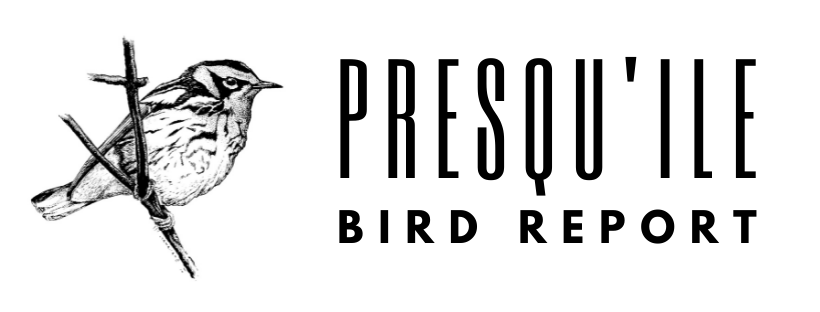Birding Report
Declining temperatures and much inclement weather have made songbird flocks harder to find about the park. Flock diversity continues to drop. On or near the water, however, birding, with wind permitting, has been good. The large mixed-flock, gull feeding-frenzies, usually present in Popham Bay in late October and early November, have already begun. These flocks are often very productive for those lucky enough to find one close to shore
A single CACKLING GOOSE was seen among CANADA GEESE on October 9 and 10. Four banded members of the latter species were seen on October 14. Duck numbers have continued to rise with ten or more GADWALLS seen off Gull Island on October 15 and 23 AMERICAN BLACK DUCKS spotted there on the same day. The GREEN-WINGED TEAL flock has maintained itself at about 100 birds and, far out in Presqu'ile Bay on October 15, a raft of several thousand REDHEADS and scaup was observed.
GREATER SCAUP are beginning to mass in mid-Popham Bay, as must be WHITE-WINGED SCOTERS, based on the high number of dead birds washing up on the beach. Patrols are in action about the region to collect the ducks in order to attempt to determine the reason for their mortality. RED-BREASTED MERGANSERS, whose numbers have spiked over the last week are usually eager participants in the aforementioned feeding-frenzies. A spotting scope can usually turn up several HORNED GREBES off Owen Point.
TURKEY VULTURES, which are still migrating west along the lakeshore, have been making detours to the Presqu'ile beach in order to dine on ill-fated WHITE-WINGED SCOTERS. A BALD EAGLE flew towards Gull Island on October 13 and NORTHERN HARRIERS are still being seen on most outings. RED-TAILED HAWKS remain common over High Bluff Island and about Owen Point, as are MERLINS in the same regions. PEREGRINE numbers have declined but one was seen near Beach 1 on October 13.
Shorebirding is still very good with 11 species being seen over the week. Most birds frequent the Owen Point/Gull Island region. BLACK-BELLIED PLOVERS, numbering around five or six birds all week, spiked to at least 15 on October 15. A single AMERICAN GOLDEN PLOVER was seen on Gull Island on October 13. SEMIPALMATED PLOVERS were down to three individuals on Gull Island on October 15. A noisy GREATER YELLOWLEGS flew about the beach during the morning of October 13. SANDERLINGS, of late the park's most numerous shorebird, dropped from 75 birds on October 13 to less than 20 on the 15th.
Declining LEAST SANDPIPER numbers bottomed out at one on October 15 and WHITE-RUMPED SANDPIPERS persist in small numbers. A single BAIRD'S SANDPIPER was seen on Gull Island on October 15, while numbers of PECTORAL SANDPIPERS rose through the week to peak at 11 on the same date. DUNLIN have replaced SANDERLINGS as the park's most numerous shorebird and exceeded 60 birds on October 15. An AMERICAN WOODCOCK was flushed near the Lighthouse, also on October 15.
The feeding-frenzies mentioned earlier auger well for gull watches and another positive sign is the increase of BONAPARTE'S GULLS in Popham Bay. Numbers of these appealing, little gulls went from a handful early in the week to several hundred by October 15. Owen Point yielded a LESSER BLACK-BACKED GULL in close to juvenile plumage on October 15. Though now being afflicted with a yet to be determined ailment, numbers of GREAT BLACK-BACKED GULLS now exceed twenty.
There were no reports of YELLOW-BELLIED SAPSUCKERS over the week though DOWNY'S, HAIRY'S, NORTHERN FLICKERS AND PILEATED WOODPECKERS were all seen. EASTERN PHOEBES were the week's only reported flycatcher and were seen in diminishing numbers amidst mixed songbird flocks. HORNED LARKS were regularly reported in small numbers on the beach or on Gull Island.
Flocks of BLACK-CAPPED CHICKADEES were observed launching ill-fated migration sorties from Owen Point on October 13 and 15. Both species of nuthatches and of kinglets were regular in the park all week. October 13 off Paxton Drive yielded several HERMIT THRUSHES, a late WOOD THRUSH and good numbers of AMERICAN ROBINS.
Warblers encountered were mostly YELLOW-RUMPED and PALM although a bright male AMERICAN REDSTART was seen near Owen Point on October 11. Sparrows were numerous throughout the week with most being SONG, WHITE-THROATEDorWHITE-CROWNED. FOX SPARROWS have been seen in nearby Brighton so should begin to show up at park area feeders in the near future. DARK-EYED JUNCOS are now common in any sparrow flock.
To reach Presqu'ile Provincial Park, follow the signs from Brighton. Locations within the Park are shown on a map at the back of a tabloid that is available at the Park gate.
Visitors to Gull Island not using a boat should be prepared to wade through knee-deep water in which there is often a swift current and a substrate that is somewhat uneven and slippery. It should also be noted that, because duck hunting is given priority on Mondays, Wednesdays, Fridays, and Saturdays, Gull Island, High Bluff Island, Owen Point, and part of the calf pasture are not available for bird-watching on those days until December 20.
Birders are encouraged to record their observations on the bird sightings board provided near the campground office by The Friends of Presqu'ile Park and to fill out a rare bird report for species not listed there.
Reporting for Fred Helleiner
Don Shanahan
Brighton



